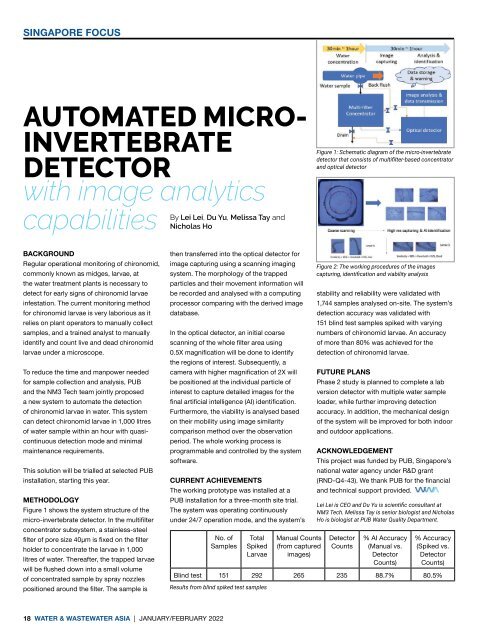Water & Wastewater Asia January/February 2022
Water & Wastewater Asia is an expert source of industry information, cementing its position as an indispensable tool for trade professionals in the water and wastewater industry. As the most reliable publication in the region, industry experts turn this premium journal for credible journalism and exclusive insight provided by fellow industry professionals. Water & Wastewater Asia incorporates the official newsletter of the Singapore Water Association (SWA).
Water & Wastewater Asia is an expert source of industry information, cementing its position as an indispensable tool for trade professionals in the water and wastewater industry. As the most reliable publication in the region, industry experts turn this premium journal for credible journalism and exclusive insight provided by fellow industry professionals. Water & Wastewater Asia incorporates the official newsletter of the Singapore Water Association (SWA).
Create successful ePaper yourself
Turn your PDF publications into a flip-book with our unique Google optimized e-Paper software.
SINGAPORE FOCUS<br />
AUTOMATED MICRO-<br />
INVERTEBRATE<br />
DETECTOR<br />
with image analytics<br />
capabilities<br />
By Lei Lei, Du Yu, Melissa Tay and<br />
Nicholas Ho<br />
Figure 1: Schematic diagram of the micro-invertebrate<br />
detector that consists of multifilter-based concentrator<br />
and optical detector<br />
BACKGROUND<br />
Regular operational monitoring of chironomid,<br />
commonly known as midges, larvae, at<br />
the water treatment plants is necessary to<br />
detect for early signs of chironomid larvae<br />
infestation. The current monitoring method<br />
for chironomid larvae is very laborious as it<br />
relies on plant operators to manually collect<br />
samples, and a trained analyst to manually<br />
identify and count live and dead chironomid<br />
larvae under a microscope.<br />
To reduce the time and manpower needed<br />
for sample collection and analysis, PUB<br />
and the NM3 Tech team jointly proposed<br />
a new system to automate the detection<br />
of chironomid larvae in water. This system<br />
can detect chironomid larvae in 1,000 litres<br />
of water sample within an hour with quasicontinuous<br />
detection mode and minimal<br />
maintenance requirements.<br />
This solution will be trialled at selected PUB<br />
installation, starting this year.<br />
METHODOLOGY<br />
Figure 1 shows the system structure of the<br />
micro-invertebrate detector. In the multifilter<br />
concentrator subsystem, a stainless-steel<br />
filter of pore size 40μm is fixed on the filter<br />
holder to concentrate the larvae in 1,000<br />
litres of water. Thereafter, the trapped larvae<br />
will be flushed down into a small volume<br />
of concentrated sample by spray nozzles<br />
positioned around the filter. The sample is<br />
then transferred into the optical detector for<br />
image capturing using a scanning imaging<br />
system. The morphology of the trapped<br />
particles and their movement information will<br />
be recorded and analysed with a computing<br />
processor comparing with the derived image<br />
database.<br />
In the optical detector, an initial coarse<br />
scanning of the whole filter area using<br />
0.5X magnification will be done to identify<br />
the regions of interest. Subsequently, a<br />
camera with higher magnification of 2X will<br />
be positioned at the individual particle of<br />
interest to capture detailed images for the<br />
final artificial intelligence (AI) identification.<br />
Furthermore, the viability is analysed based<br />
on their mobility using image similarity<br />
comparison method over the observation<br />
period. The whole working process is<br />
programmable and controlled by the system<br />
software.<br />
CURRENT ACHIEVEMENTS<br />
The working prototype was installed at a<br />
PUB installation for a three-month site trial.<br />
The system was operating continuously<br />
under 24/7 operation mode, and the system’s<br />
No. of<br />
Samples<br />
Total<br />
Spiked<br />
Larvae<br />
Results from blind spiked test samples<br />
Manual Counts<br />
(from captured<br />
images)<br />
Figure 2: The working procedures of the images<br />
capturing, identification and viability analysis<br />
stability and reliability were validated with<br />
1,744 samples analysed on-site. The system’s<br />
detection accuracy was validated with<br />
151 blind test samples spiked with varying<br />
numbers of chironomid larvae. An accuracy<br />
of more than 80% was achieved for the<br />
detection of chironomid larvae.<br />
FUTURE PLANS<br />
Phase 2 study is planned to complete a lab<br />
version detector with multiple water sample<br />
loader, while further improving detection<br />
accuracy. In addition, the mechanical design<br />
of the system will be improved for both indoor<br />
and outdoor applications.<br />
ACKNOWLEDGEMENT<br />
This project was funded by PUB, Singapore’s<br />
national water agency under R&D grant<br />
(RND-Q4-43). We thank PUB for the financial<br />
and technical support provided.<br />
Lei Lei is CEO and Du Yu is scientific consultant at<br />
NM3 Tech. Melissa Tay is senior biologist and Nicholas<br />
Ho is biologist at PUB <strong>Water</strong> Quality Department.<br />
Detector<br />
Counts<br />
% AI Accuracy<br />
(Manual vs.<br />
Detector<br />
Counts)<br />
% Accuracy<br />
(Spiked vs.<br />
Detector<br />
Counts)<br />
Blind test 151 292 265 235 88.7% 80.5%<br />
18 WATER & WASTEWATER ASIA | JANUARY/FEBRUARY <strong>2022</strong>


















